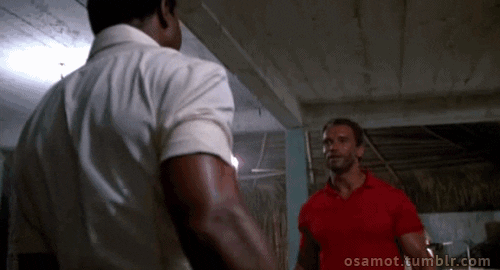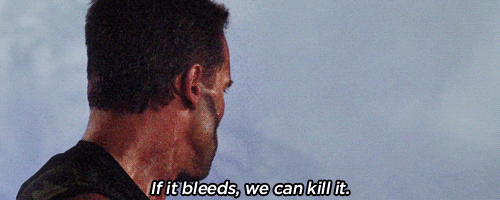Predator is a filmmaking class
📰 A breakdown of the first 10 minutes of the 80's action/horror/sci-fi hybrid
Predator, the movie from 1987, is an outstanding example of great filmmaking.
I will defend this claim in the following paragraphs, investigating the first 10 minutes of the movie.
Why? Because I like doing that. Also, I think my readers enjoy this kind of thing. Please leave feedback ❤️.
This article has a simple goal: look at this movie with a more focused view, mainly because it's a movie seen just as another 80's action flick, but, in reality, it teaches so much about storytelling, character building, and editing — in the literary meaning.
There's a lot to be said about how I cannot simply watch a movie and how every cultural item I consume is never only entertainment, but I'll leave that to my therapist.
Also, I won’t give you a technical table with all the crew information. This link can get you there.
How it works
I will write a little about each scene, but not about every one of them. You can read this without ever having seen the movie, but watching it is obviously recommended (it's fantastic, really). There will be no spoilers ahead other than the details of these first minutes.
The opening
The movie opens with a spacecraft dropping something into Earth. Nothing is explained.
It cuts, then, to a military base with helicopters. The soundtrack builds tension.
A few men drop from one of the helicopters, each with a different clothing style — there's even one with a suit and tie.
One by one, they get out, revealing a mysterious silhouette of a man smoking a cigar — the soundtrack changes when he gets out of the vehicle.
This man is important — the General's frown turns into a smile when he approaches. His name is Dutch, and he shares a long-ago past with the General.
Amongst maps, coordinates, and mission details, Dutch doesn't look so convinced by the General's story. The question "why Dutch" is promptly answered when he questions the mission: he is the best man for the job — a phrase from another character's mouth.
The movie shows us one of the strongest (pun intended) scenes of the story of cinema. Dutch walks up to this man sitting by the corner, tells us his name — Dillon — and gives him a handshake with two full seconds of screen time. That's at least 48 frames of sweat and muscle that turns into an arm wrestling competition.
Dutch knows Dillon differently than the General: he gets physical and competitive, makes fun of Dillon's current job, and gets complimented about "the Berlin job."
We learn that Dutch is not only still in business but also a good mercenary. He has ethics: some jobs are not his style. He draws his cigar and claims he and his team are rescuers, not assassins.
Dillon and the general look at each other in another two-second-that-show-a-lot scene: they are uncomfortable with Dutch's ethics. Nothing is said, but everything is told. There's something fishy going on.
Dillon interrupts the general — showing who's actually in charge — and includes himself in Dutch's mission, something denied by Dutch but quickly overturned by the General.
Pause
Not even 7 minutes have gone by, and we already know:
- The threat is not from Earth;
- A team will deal with the threat (not a single person);
- The team is diverse (different styles and clothes);
- Who is the main character (the only one smoking and in a bright-colored polo shirt);
- The protagonist's name (Dutch);
- His professional relationship and respect with a higher command (the General);
- His casual, almost disrespectful, relationship with his colleague from old times (Dillon);
- How he's still doing his job while Dillon became an office worker;
- His experience;
- His excellent reputation;
- His moral compass;
- His lack of confidence in the general and Dillon;
- The plan — there's something flawed about it;
- Who is actually in charge: Dillon;
- Dutch's opposition to Dillon's presence in the mission;
These scenes perfectly exemplify the motto "show, don't tell." Whenever someone asks you about this, play this movie.
It lays out so much significant information without pause that we already have something invested in the story in less time than pasta gets cooked.
The team
After this conversation, the movie shows a very difficult-to-digest montage. It's scene after scene of the helicopter taking the team to the mission. After so much information thrown at us, this part even looks banal, boring, and bland. But, as with many things in this movie, there's an apparent reason for these scenes to exist. They — again — show us a lot of information without needing a single line of explanation.
Two choppers fly over the jungle. Dutch is listening on headphones and answering questions — he's in charge. One of the team members bangs his head at loud rock'n'roll and eats a handful of something that every soldier in the vehicle denies — it doesn't look appetizing.
A face-painted man makes a tape ball and throws it towards a nerdy-looking team member — he reads a newspaper and wears thick glasses. He's a nerd, but he's not slow, as he catches the ball mid-air.
Dillon also talks to someone over headphones — oops, who's in charge again? — and tells Dutch there's no backup expected. In "The Hero's Journey," this is the point of no return.
The nerd soldier tries telling a joke to a man by his side, but the colleague doesn't show the minimum appreciation. Is nerdy not funny, or is the other one too harsh? Maybe both?
We can see one of the soldiers shaving a clean face, almost as a tic or ritual.
The very macho soldier, eating whatever that is — it looks disgusting — spits on Dillon's boots. No one in this team likes the CIA operative.
Pause
Just about three minutes have passed. We now know a little about the personality of each team member.
One feels he's better than everyone — he calls himself a sexual tyrannosaur and spits in Dillon's boot. Another one tries to make funny jokes without success. The other is harsh and serious; maybe he wouldn't laugh even after the best joke on Earth.
One soldier has a strange habit — shaving his baby-clean face — and the other makes fun of his colleagues — shown by his tape-ball-throwing skills.
Also, Dillon and Dutch's relationship is explored more in a few simple lines: their past as colleagues and Dutch's lack of trust in Dillon's information.
Ten minutes
This opening shows us much about what's coming, with an excellent economy of phrases and scenes. From this moment on, the movie progresses — from an action movie to a horror and sci-fi story.
Not all is perfect, though. Genuinely I'm not too fond of a specific scene: one soldier is surprised by an invisible enemy and starts mindlessly shooting. Everyone follows: they arrive, point their guns at nowhere, and empty clips after clips. The first shooter is holding a minigun — a weapon designed to be used mounted, which burns $150 of ammo per second. They even end the scene by saying, "we hit nothing!"
The director clarified this scene in an interview, expressing it was meant to look silly and purposeless. Still, I wouldn't say I like it, even after understanding the motivation.
What's next?
I recommend watching the movie and paying attention to the genuinely great script: how information is given without lengthy explanations, how the character's personality is shown by their actions, how the Dutch attempt to weaken the enemy succeed — he's our hero! — but also fails — the enemy is intelligent.
Also, the movie has a nice amount of one-liners that would be repeated and reused throughout Hollywood’s history.
Listen!
Another highlight of the movie is the soundtrack by Alan Silvestri — he did the Avengers theme, so, yeah, he knew what he was doing since forever.
The soundtrack is perfect. It builds tension when needed and alleviates it at the right moments.
Play the video above and look around: are you sure you are alone now?
Conclusion
I honestly could write about the whole movie, from start to finish, but I'll spare you from all this. The focus of this article, as said in the beginning, was to show you how much can be done in 10 minutes of footage, and I think I achieved that goal.
I hope you enjoyed this piece of analysis. If so, like this publication on Substack and comment it with your feelings. Subscribe to this newsletter to receive stuff like this — and distinct things I am not sure about yet. Let’s find out together.









